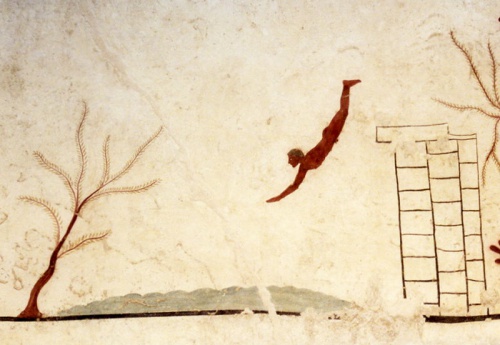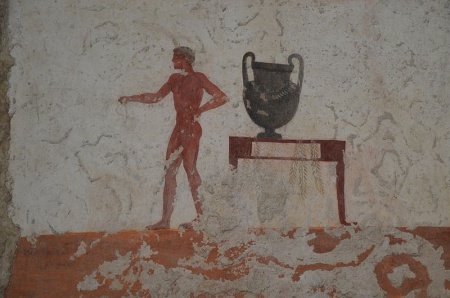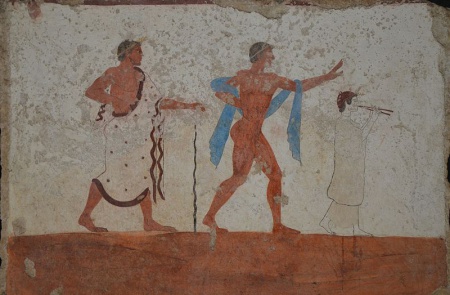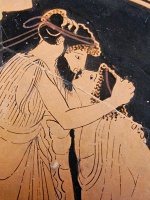Tomb of the Diver
| Part of the boylove history series |
 |
| Portal:History |
The Tomb of the Diver is an archaeological monument, found by the Italian archaeologist Mario Napoli on 3 June 1968 during his excavation of a small necropolis about 1.5 km south of the Greek city of Paestum in Magna Graecia, in what is now southern Italy. The tomb is now displayed in the museum at Paestum. [1]
It is a grave made of five local limestone slabs forming the four lateral walls and the roof, the floor being excavated in the natural rock ground. The five slabs, accurately bonded with plaster, formed a chamber sized — roughly – 215 × 100 × 80 cm (7.1 × 3.3 × 2.6 ft). All five slabs forming the monument were painted on the interior sides using a true fresco technique. The paintings on the four walls depict symposium scenes, while the cover slab shows the famous scene that gives the tomb its name: a young man diving into a curling and waving stream of water. At least two different fresco painters (muralists) appear have been involved in the tomb's creation, the south wall being by a less impressive artist than the others.[2]
When the tomb was discovered, these surprising frescos revealed its importance as they appear to be the "only example of Greek painting with figured scenes dating from this period to have survived in its entirety. Among the thousands of Greek tombs known from this time (roughly 700–400 BC), this is the only one to have been decorated with frescoes of human subjects."[3]
In the interior of the tomb, only a few objects were found: near the corpse (widely supposed to be a young man, despite the heavily deteriorated state of the skeleton) were a turtle shell,[4] two aryballos (An aryballos (Greek: ἀρύβαλλος) was a small spherical or globular flask with a narrow neck used in Ancient Greece. It was used to contain perfume or oil, and is often depicted in vase paintings being used by athletes during bathing.) and an Attic lekythos (A lekythos (plural lekythoi) is a type of Greek pottery used for storing oil (Greek λήκυθος), especially olive oil. It has a narrow body and one handle attached to the neck of the vessel.). These must have been the deceased youth's oil flasks, the ones he used to oil himself for wrestling practice at the gymnasium or palaestra, and his favorite drinking cup, painted in black-figure technique from about 480 BC, which helped the discoverer and other scholars to date the tomb to about 470 BC.
Over the years, many scholars have speculated on the identity of the youth from the Tomb of the Diver. Was he someone of rank and stature or a simple farm boy? Perhaps given the tone of the homoerotic symposium imagery and the care that went into his interment, he was someone's beloved boy (eromenos) whose lover (erastes) so moaned his loss that he had built for him this fine and atypical tomb.
Images
   |
  |
Notes
- R. Ross Holloway. The Tomb of the Diver, in American Journal of Archaeology, Vol. 110, n. 3, July 2006 (pp. 365–388).
- Angela Pontrandolfo, Agnès Rouveret, Marina Cipriani. The painted tombs of Paestum. Pandemos Editions, Paestum, 2004 ISBN 88-87744-11-4; other versions: French ISBN 88-87744-13-0; German ISBN 88-87744-12-2; Italian ISBN 88-87744-10-6;
- Agnès Rouveret. La Tombe du Plongeur et les fresques étrusques: témoignages sur la peinture grecque, dans Revue Archéologique, 1974, Fascicule 1, pp. 15–32.
- Pierre Somville. La tombe du plongeur à Paestum, dans Revue de l'histoire de Religions.Paris, PUF, Tome 196, fascicule 1, July 1979, pp. 41–51.
- Daisy Warland. La Tombe du Plongeur: Étude de la relation entre le symposion et le plongeon. dans Revue de l'histoire de Religions. Paris, PUF, Tome 213, fascicule 2, 1996, p. 143–60 – Abstract on line 23 August 2007. accessed 20 September 2007.
- Daisy Warland. Que représente la fresque de la paroi Ouest de la tombe au plongeur de Poseidonia?, in Kernos, 1999, n. 12, p. 195–206.
References
- ↑ Tomb of the Diver from Wikipedia
- ↑ Holloway, p. 373.
- ↑ Holloway, p. 365.
- ↑ Probably part of a lyre whose wooden frame had rotted away.

